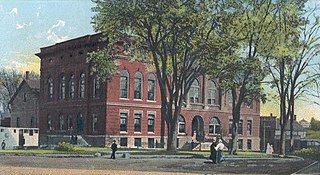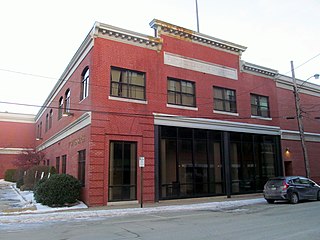
Kennebec County is a county located in the South-central portion of the U.S. state of Maine. At the 2020 census, the population was 123,642. Its county seat is Augusta, the state capital. The county was established on February 20, 1799, from portions of Cumberland and Lincoln Counties. The name Kennebec comes from the Eastern Abenaki /kínipekʷ/, meaning "large body of still water, large bay."

Waterville is a city in Kennebec County, Maine, United States, on the west bank of the Kennebec River. The city is home to Colby College, Thomas College, and the headquarters of HealthReach Community Health Centers. As of the 2020 census the population was 15,828. Along with Augusta, Waterville is one of the principal cities of the Augusta-Waterville, ME Micropolitan Statistical Area.

Oakland is a town in Kennebec County in the U.S. state of Maine. The population was 6,230 at the 2020 census. Oakland is 4 miles (6 km) west of Waterville and approximately 18 miles (29 km) north of Augusta, the state capital. Waterville and Augusta are service centers for Oakland, and many Oakland residents commute to jobs in those areas.

The Kennebec River is a 170-mile-long (270 km) river within the U.S. state of Maine. It rises in Moosehead Lake in west-central Maine. The East and West Outlets join at Indian Pond and the river flows southward. Harris Station Dam, the largest hydroelectric dam in the state, was constructed near that confluence. The river is joined at The Forks by its tributary the Dead River, also called the West Branch.

The St. Lawrence and Atlantic Railroad, known as St-Laurent et Atlantique Quebec in Canada, is a short-line railway operating between Portland, Maine, on the Atlantic Ocean, and Montreal, Quebec, on the St. Lawrence River. It crosses the Canada–US border at Norton, Vermont, and Stanhope, Quebec, and is owned by short-line operator Genesee & Wyoming.

The Maine Central Railroad was a U. S. class 1 railroad in central and southern Maine. It was chartered in 1856 and began operations in 1862. By 1884, Maine Central was the longest railroad in New England. Maine Central had expanded to 1,358 miles (2,185 km) when the United States Railroad Administration assumed control in 1917. The main line extended from South Portland, Maine, east to the Canada–United States border with New Brunswick, and a Mountain Division extended west from Portland to St. Johnsbury, Vermont, and north into Quebec. The main line was double track from South Portland to Royal Junction, where it split into a "lower road" through Brunswick and Augusta and a "back road" through Lewiston, which converged at Waterville into single track to Bangor and points east. Branch lines served the industrial center of Rumford, a resort hotel on Moosehead Lake and coastal communities from Bath to Eastport.
The Penobscot and Kennebec Railroad (P&K) is a historic U.S. railroad which operated in Maine.
The European and North American Railway (E&NA) is the name for three historic Canadian and American railways which were built in New Brunswick and Maine.

The railroad history of Portland, Maine, began in 1842 with the arrival of the Portland, Saco & Portsmouth Railway (PS&P). Most of the rail activity in Portland revolved around agricultural goods bound for export and import freight from Europe. Yet Maine's largest city also enjoyed 125 years of continuous passenger rail service, from 1842 until 1967, and Amtrak began serving the city in 2001. For most of Portland's history, passenger train schedules were designed with intercity travel rather than daily commuting in mind; passenger activities were mostly confined to intercity travel from Portland to Boston, Montreal, Nova Scotia, and points west.

WTVL was a commercial AM radio station licensed to serve Waterville, Maine, and serving Kennebec County. The station was owned by Townsquare Media and until January 2023, it broadcast an adult standards radio format, playing softer hits from the 1950s, '60s, '70s, and '80s. The station featured the music of Frank Sinatra, Barbra Streisand, Nat King Cole and Dionne Warwick in its playlist.

Samuel Page Benson was a United States representative from Maine. He was born to Peleg and Sally Benson in Winthrop, Massachusetts on November 28, 1804. He received instruction from private teachers and attended the Monmouth Academy of Maine. He graduated from Bowdoin College in 1825. He studied law, was admitted to the bar and commenced practice in Unity. He returned to Winthrop and practiced law until 1850.

The Rockland Branch is a railroad from Brunswick, Maine to Rockland, Maine. A charter was granted in 1849 to build a railway from the Portland and Kennebec Railroad on the west side of the Kennebec River to Rockland. Construction through the rocky headlands of the Atlantic coast proved more expensive than anticipated. The Knox and Lincoln Railroad commenced service to Rockland in 1871 using a ferry to cross the Kennebec River between Bath and Woolwich. The Knox and Lincoln was leased by Maine Central Railroad in 1891, and became Maine Central's Rockland Branch in 1901. Maine Central purchased the Samoset destination hotel in nearby Glen Cove in 1912, and offered direct passenger service for summer visitors from the large eastern cities. Carlton bridge was completed in 1927 to carry the railroad and U.S. Route 1 over the Kennebec River. Maine Central sold the Samoset hotel in 1941, and the last Maine Central passenger train to Rockland was on 4 April 1959. The State of Maine purchased the branch in 1987 to prevent abandonment. The line has subsequently been operated by the Maine Coast Railroad, the Maine Eastern Railroad, and, beginning in 2016, the Central Maine and Quebec Railway. In 2019, Canadian Pacific Railway agreed to purchase the Central Maine and Quebec, thereby inheriting the operation of the Rockland Branch. The acquisition was completed on June 3, 2020.

The Maine Central Railroad Rumford Branch is a railroad line in Maine now operated as part of the Pan Am Railways system. The Rumford Branch leaves the mainline at Leeds Junction and continues northwest up the Androscoggin River valley, passing through Livermore Falls and terminating at Rumford. The branch comprises the remaining trackage of three earlier branches:

Lewiston–Auburn (L–A) are twin cities in Androscoggin County, Maine, USA. Together, they have a population of 61,182 in a combined 101 square miles (260 km2). The cities are commonly called "Cities of the Androscoggin," as they are seated along the banks of the Androscoggin River which separates them. They share infrastructure and transportation, such as the Lewiston-Auburn CityLink, the Lewiston and Auburn Railroad Company and the Auburn/Lewiston Municipal Airport. They also form the Lewiston-Auburn Metropolitan Statistical Area, which encompasses Androscoggin County. The Lewiston–Auburn Economic Growth Council has been promoting the cities as one community for decades in its campaign to promote growth in industry and business.
Below is a list of the members of the 124th Maine Senate, which were sworn into office on December 3, 2008, and left office in December 2010.
The Somerset and Kennebec Railroad was a 19th-century Maine railroad which became part of the Maine Central Railroad.
Below is a list of the members of the 121st Maine Senate, which were sworn into office in December 2002 and left office in December 2004.

The Maine Central Railroad Company main line extended from Portland, Maine, east to the Canada–US border with New Brunswick at the Saint Croix–Vanceboro Railway Bridge. It is the transportation artery linking Maine cities to the national railway network. Sections of the main line had been built by predecessor railroads consolidated as the Maine Central in 1862 and extended to the Canada–US border in 1882. Through the early 20th century, the main line was double track from South Portland to Royal Junction, where it split into a lower road through Brunswick and Augusta and a back road through Lewiston which converged at Waterville into single track to Bangor and points east. Westbound trains typically used the lower road with lighter grades, while eastbound trains of empty cars used the back road. This historical description does not include changes following purchase of the Maine Central Railroad by Guilford Transportation Industries in 1981 and subsequent operation as part of Pan Am Railways.

The Portland–Lewiston Interurban (PLI) was an electric railroad subsidiary of the Androscoggin Electric Company operating from 1914 to 1933 between Monument Square in Portland and Union Square in Lewiston, Maine. Hourly service was offered over the 40-mile (64 km) route between the two cities. Express trains stopping only at West Falmouth, Gray, New Gloucester, Upper Gloucester and Danville made the trip in 80 minutes, while trains making other local stops upon request required 20 minutes more. The line was considered the finest interurban railroad in the state of Maine.














